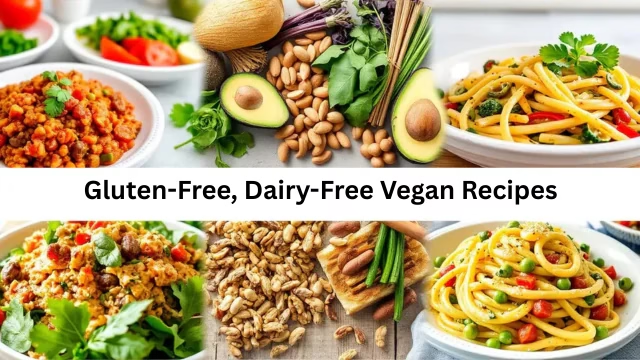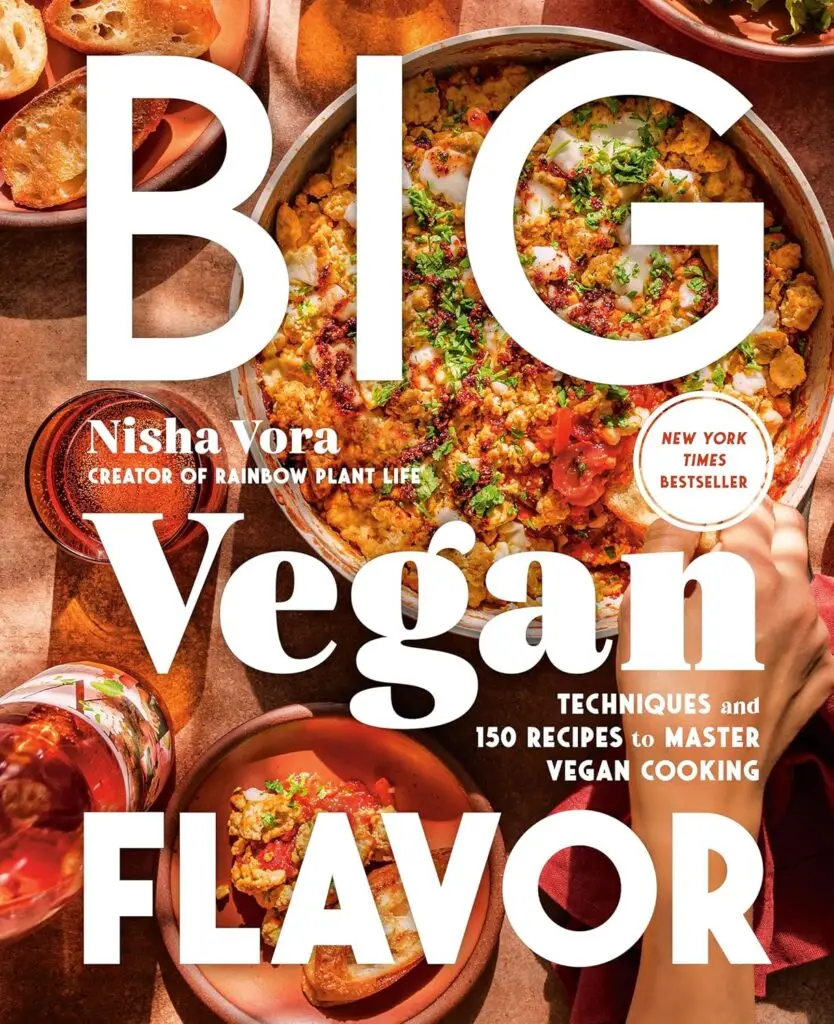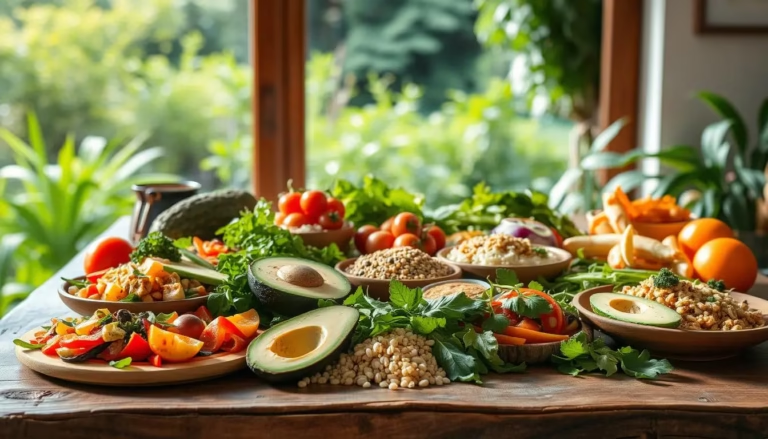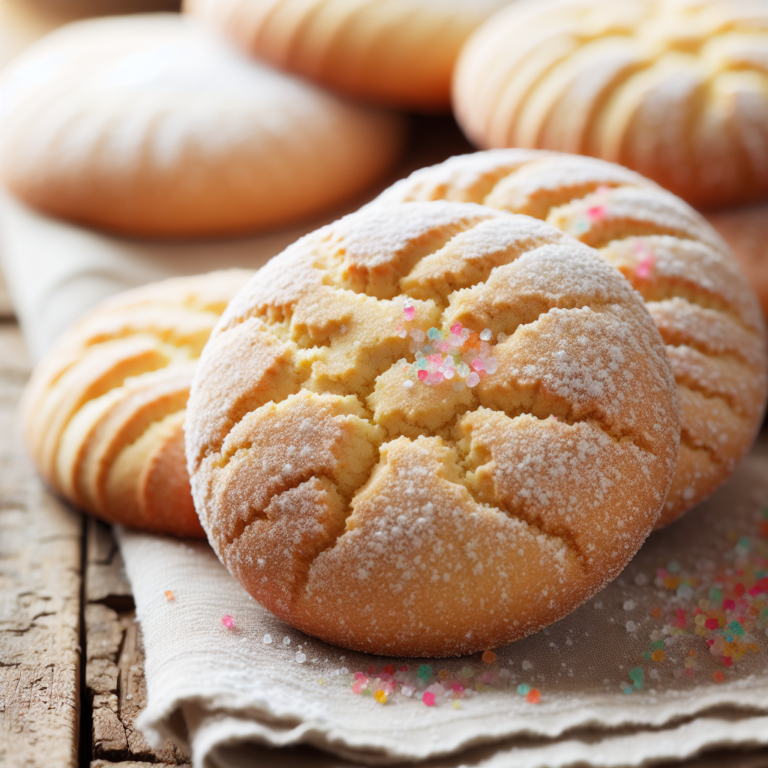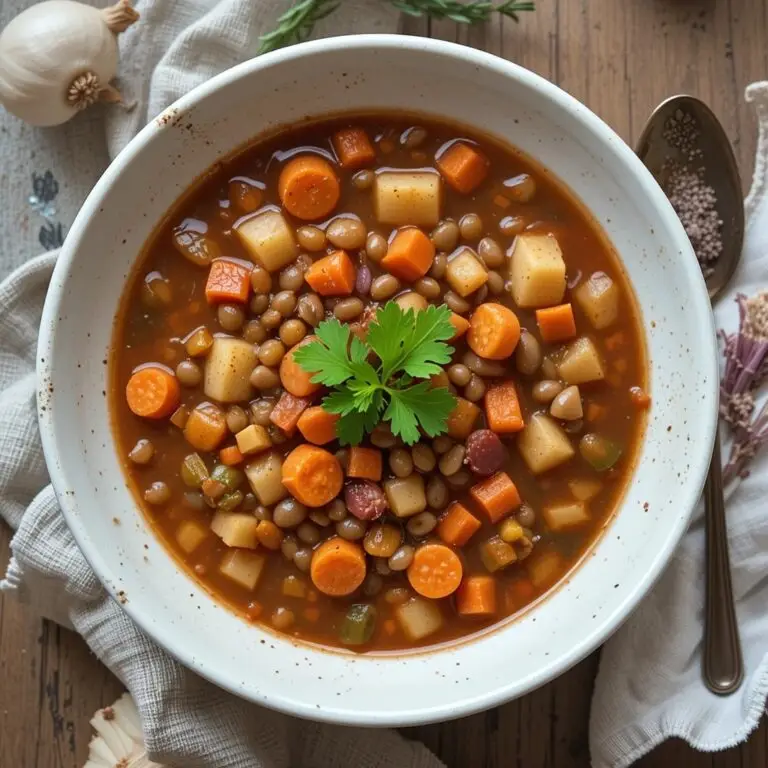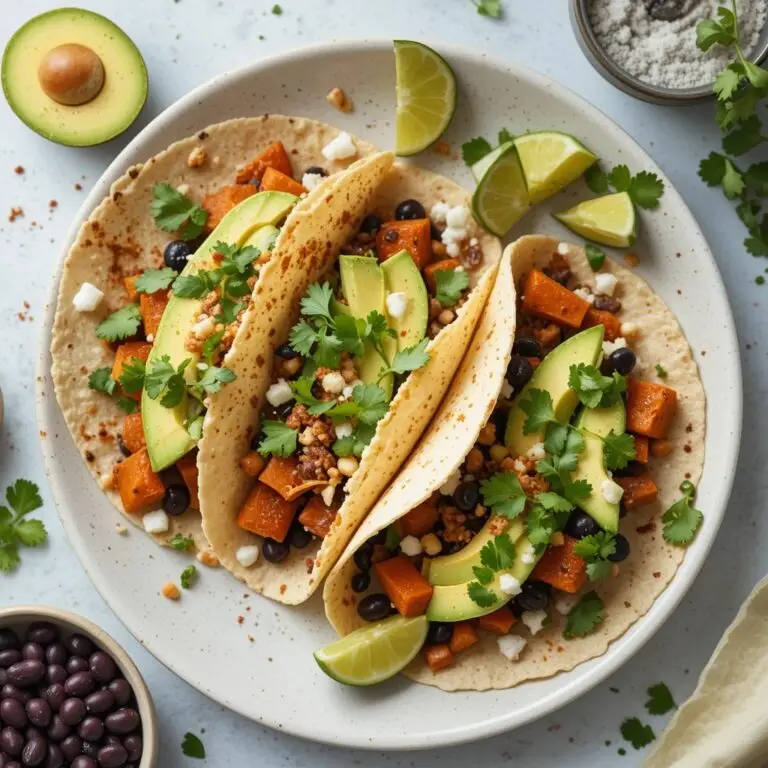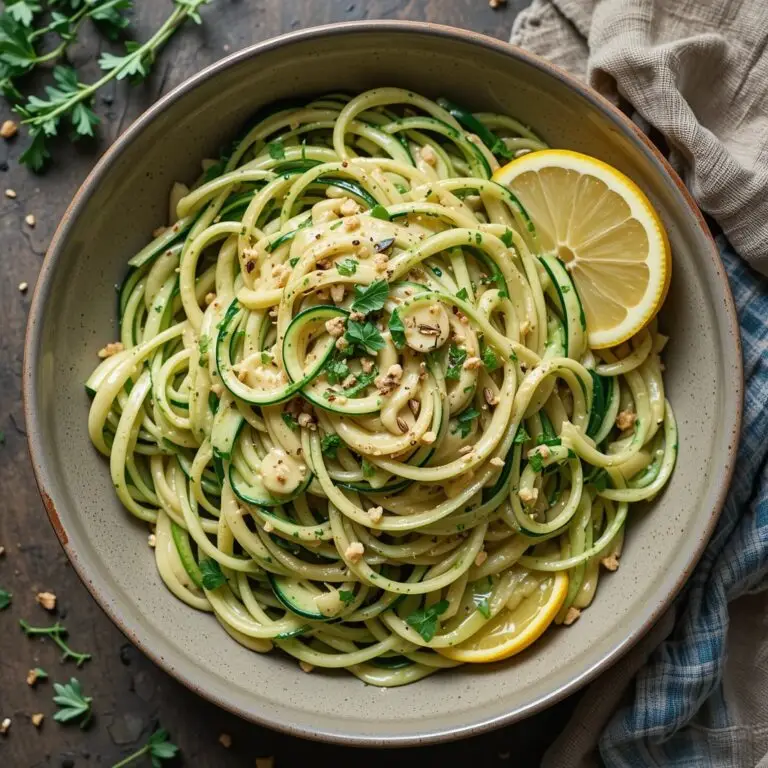Gluten-Free, Dairy-Free Vegan Recipes: 5 Delicious Dishes Everyone Will Love
Gluten-free, dairy-free vegan recipes can transform your eating habits without sacrificing flavor or satisfaction. These carefully crafted dishes prove that dietary restrictions lead to culinary creativity, offering nutrient-dense meals that delight everyone at your table.
Discover the joy of cooking and eating with recipes that are not only good for you but also delightful to share with friends and family.
Why Choose Gluten-Free, Dairy-Free & Vegan Recipes?
Adopting gluten-free, dairy-free, and vegan recipes offers numerous benefits:
✔ Improved digestion from eliminating common irritants
✔ Reduced inflammation thanks to plant-powered ingredients
✔ Higher nutrient density with whole-food ingredients
✔ Ethical and sustainable eating choices
The Triple-Free Diet Revolution
A growing number of people are embracing the triple-free diet for its numerous health benefits. This dietary choice involves eliminating gluten, dairy, and animal products, which can have a significant impact on overall health.
Health Benefits of Eliminating Gluten, Dairy, and Animal Products
Eliminating gluten, dairy, and animal products can lead to several health benefits. Some of the key advantages include improved digestion, reduced inflammation, and increased energy levels. A diet free from these products can also help manage chronic conditions such as arthritis and diabetes.
Moreover, a triple-free diet is rich in antioxidants and fiber, which can enhance overall well-being and support weight management. By focusing on whole, plant-based foods, individuals can experience a significant improvement in their health.
Common Challenges and Misconceptions
Despite the benefits, adopting a triple-free diet can be challenging. One common misconception is that it’s difficult to get enough protein without dairy or animal products. However, there are numerous plant-based protein sources such as legumes, nuts, and seeds that can easily meet daily protein needs.
Another challenge is navigating social situations and eating out. With a little planning and creativity, it’s possible to enjoy a delicious and satisfying triple-free meal even in challenging environments.
Understanding Gluten-Free, Dairy-Free & Vegan Dietary Needs
For individuals considering or already following a gluten-free, dairy-free, and vegan diet, understanding the dietary requirements is crucial. This lifestyle choice is not just about avoiding certain foods; it’s about embracing a comprehensive approach to health and wellness.
Who Needs These Dietary Restrictions?
Individuals with specific health conditions or preferences may benefit from a gluten-free, dairy-free, and vegan diet. Those with celiac disease, lactose intolerance, or ethical and environmental concerns often adopt this lifestyle. Understanding the reasons behind these dietary choices can help in making informed decisions.
Essential Pantry Staples
Stocking the right pantry staples is vital for a smooth transition to a gluten-free, dairy-free, and vegan diet. Essentials include gluten-free grains like rice and quinoa, plant-based milks, and vegan-friendly snacks. Having these staples on hand makes meal preparation easier and more efficient.
Ingredient Substitutions Guide
Navigating ingredient substitutions is a crucial skill for those on a gluten-free, dairy-free, and vegan diet. Here are some key substitutions to know:
Gluten Alternatives
Use almond flour or coconut flour as substitutes in baking. These alternatives provide structure and texture similar to gluten-containing flours.
Dairy Replacements
Almond milk, soy milk, and coconut milk are excellent dairy-free alternatives for beverages and cooking.
Egg and Meat Substitutes
For eggs, use flaxseed or mashed banana as binding agents. For meat, opt for tofu, tempeh, or plant-based meat alternatives.
Creamy Coconut Thai Curry with Rainbow Vegetables
Indulge in the rich flavors of Thailand with our Creamy Coconut Thai Curry recipe, featuring a vibrant mix of rainbow vegetables. This dish is not only a treat for the taste buds but also a feast for the eyes, with its colorful array of vegetables and creamy coconut sauce.
Ingredients List
For the Curry Base
- 1 can full-fat coconut milk
- 2 tablespoons coconut oil
- 2 cloves garlic, minced
- 1 tablespoon grated fresh ginger
- 2 tablespoons Thai red curry paste
- 1 teaspoon turmeric powder
- Salt, to taste
For the Vegetable Medley
- 1 cup bell peppers, sliced
- 1 cup carrots, peeled and sliced
- 1 cup zucchini, sliced
- 1 cup cherry tomatoes, halved
- 1 cup broccoli florets
- Fresh basil leaves, for garnish
Step-by-Step Cooking Instructions
Start by heating the coconut oil in a large pan over medium heat. Add the minced garlic and grated ginger, sautéing until fragrant. Stir in the Thai red curry paste and turmeric powder, cooking for another minute. Pour in the coconut milk, bringing the mixture to a simmer. Let it cook for about 10 minutes, stirring occasionally, until the sauce thickens. Add the sliced vegetables and cook until they are tender. Season with salt to taste.
Serving Suggestions and Variations
Spice Level Adjustments
For those who prefer a spicier curry, add more Thai red curry paste or a few dashes of hot sauce. Conversely, for a milder version, reduce the amount of curry paste or omit the seeds and membranes of the chili peppers.
Protein Additions
To boost the protein content, consider adding tofu, tempeh, or chickpeas to the curry. You can also include cooked vegan chicken or shrimp for added variety.
This Creamy Coconut Thai Curry is a versatile and delicious dish that can be enjoyed on its own or paired with rice or noodles. Feel free to experiment with different vegetables and protein sources to make it your own.
Hearty Southwest Quinoa and Black Bean Stuffed Peppers
Discover the vibrant flavors of the Southwest with our quinoa and black bean stuffed peppers recipe. This dish is not only a feast for the eyes but also packed with nutrients, making it a perfect option for a healthy meal. The combination of quinoa, black beans, and a variety of spices brings a delightful southwest twist to the classic stuffed peppers.
Ingredients List
To make this delicious and nutritious dish, you’ll need the following ingredients:
- 4 large bell peppers, any color
- 1 cup quinoa, rinsed and drained
- 2 cups water or vegetable broth
- 1 tablespoon olive oil
- 1 onion, finely chopped
- 2 cloves garlic, minced
- 1 cup black beans, drained and rinsed
- 1 cup corn kernels
- 1 teaspoon cumin
- 1 teaspoon chili powder
- Salt and pepper, to taste
- 1 cup vegan cheese shreds (optional)
- Fresh cilantro, chopped (for garnish)
| Ingredient | Quantity | Nutritional Highlight |
|---|---|---|
| Quinoa | 1 cup | Complete protein, fiber |
| Black Beans | 1 cup | High in fiber, folate |
| Bell Peppers | 4 | Rich in vitamin C, antioxidants |
Step-by-Step Cooking Instructions
Preparing the Peppers
Start by preheating your oven to 375°F (190°C). Cut the tops off the bell peppers and remove the seeds and membranes. Place them in a baking dish.
Making the Filling
In a medium saucepan, bring the quinoa and water or broth to a boil. Reduce the heat to low, cover, and simmer for about 15-20 minutes, or until the quinoa is tender. In a large skillet, heat the olive oil over medium heat. Add the onion and garlic and cook until softened. Stir in the black beans, corn, cumin, and chili powder. Cook for a few minutes until heated through. Combine the cooked quinoa with the black bean mixture.
Baking and Finishing
Divide the quinoa and black bean mixture among the peppers, filling them as full as possible. Cover the baking dish with aluminum foil and bake for 25 minutes. Remove the foil and top with vegan cheese shreds if using. Return to the oven and bake for an additional 10-15 minutes, or until the peppers are tender.
Serving Suggestions and Variations
These stuffed peppers can be served as a main dish or as part of a larger meal. Consider adding a side salad or some steamed vegetables. For variations, you can change the type of beans or add other vegetables like diced tomatoes or chopped mushrooms. Experiment with different spices to adjust the level of heat to your liking.
Decadent No-Bake Chocolate Avocado Mousse
Indulge in the rich flavors of our Decadent No-Bake Chocolate Avocado Mousse, a perfect treat for anyone following a gluten-free, dairy-free, and vegan diet. This dessert is not only delicious but also packed with healthy fats from avocados, making it a guilt-free pleasure.
Ingredients List
To make this decadent dessert, you’ll need the following ingredients:
- 3 ripe avocados
- 1/2 cup unsweetened cocoa powder
- 1/4 cup maple syrup
- 1/4 cup coconut cream
- 1 teaspoon vanilla extract
- Pinch of salt
- 1 cup dairy-free chocolate chips
Step-by-Step Preparation Instructions
Preparing this no-bake chocolate mousse is straightforward. Follow these steps:
- Scoop the avocado flesh into a blender or food processor.
- Add the cocoa powder, maple syrup, coconut cream, vanilla extract, and salt to the blender.
- Blend until smooth and creamy, stopping to scrape down the sides as needed.
- Melt the dairy-free chocolate chips in a double boiler or in the microwave in 30-second increments, stirring between each interval until smooth.
- Fold the melted chocolate into the avocado mixture until well combined.
- Spoon the mousse into individual serving cups or a large serving dish.
- Refrigerate for at least 2 hours before serving.
Serving Suggestions and Variations
This vegan dessert is versatile and can be served in various ways. Here are some ideas:
Topping Ideas
- Fresh berries or sliced strawberries
- Coconut whipped cream
- Chopped nuts or shaved chocolate
Flavor Variations
- Add a pinch of coffee powder for a mocha flavor
- Use different types of non-dairy milk to change the consistency
- Add a teaspoon of orange or mint extract for a unique twist
Enjoy your Decadent No-Bake Chocolate Avocado Mousse, a true delight for anyone looking for a gluten-free, dairy-free, and vegan dessert option.
Savory Lentil and Root Vegetable Shepherd’s Pie
Discover the ultimate vegan comfort food with our Savory Lentil and Root Vegetable Shepherd’s Pie recipe. This dish is a perfect blend of nutritious ingredients and rich flavors, making it an ideal meal for any occasion.
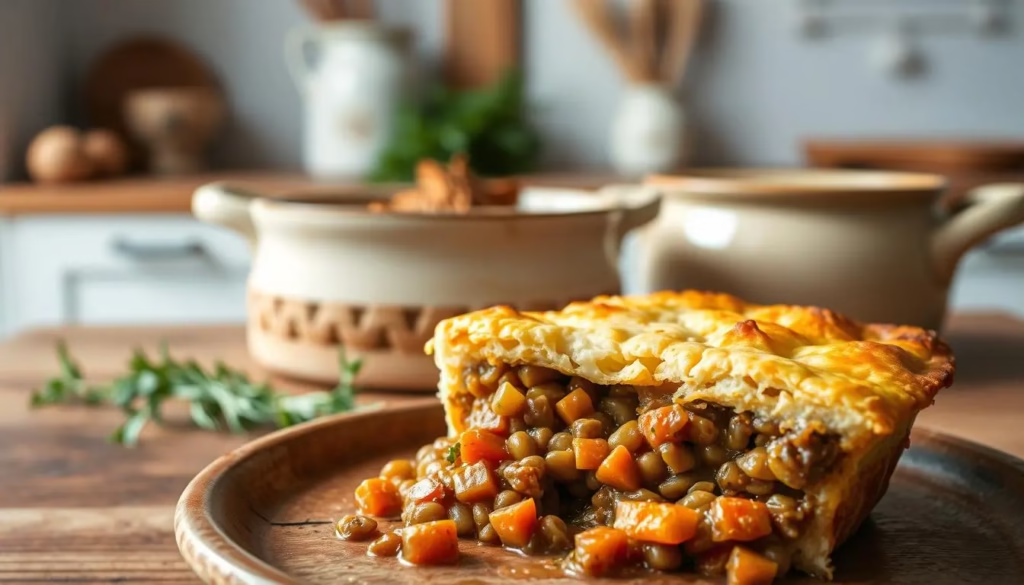
Ingredients List
For the Lentil Base
- 1 cup green or brown lentils, rinsed and drained
- 2 cups vegetable broth
- 1 large onion, chopped
- 2 cloves garlic, minced
- 2 medium carrots, peeled and chopped
- 1 large celery stalk, chopped
- 1 cup diced tomatoes
- 1 tsp dried thyme
- 1 tsp dried rosemary
For the Potato Topping
- 3-4 large potatoes, peeled and chopped
- 1/4 cup vegan butter or margarine
- 1/2 cup non-dairy milk
- Salt and pepper to taste
Step-by-Step Cooking Instructions
Start by preheating your oven to 375°F (190°C). Cook the lentils in vegetable broth until tender, then set aside. In a large pan, sauté the onion, garlic, carrots, and celery until the vegetables are softened. Add the diced tomatoes, thyme, and rosemary, and cook for a further 5 minutes. Combine the cooked lentils with the vegetable mixture and season to taste.
For the potato topping, boil the chopped potatoes until tender. Drain and mash with vegan butter or margarine and non-dairy milk. Season with salt and pepper to taste.
Transfer the lentil mixture to a baking dish, top with the mashed potatoes, and bake for 25-30 minutes, or until the potato topping is golden brown.
Serving Suggestions and Variations
Serve hot, garnished with fresh herbs. You can also customize this recipe by adding other root vegetables or spices to suit your taste. For a gluten-free and dairy-free meal, this Savory Lentil and Root Vegetable Shepherd’s Pie is a perfect choice, offering a comforting and satisfying vegan comfort food experience.
Fluffy Breakfast Berry and Banana Oat Pancakes
Discover a delightful twist on traditional pancakes with our gluten-free, dairy-free, and vegan Fluffy Breakfast Berry and Banana Oat Pancakes recipe. This mouth-watering breakfast dish is not only delicious but also packed with nutritious ingredients to kick-start your day.
Ingredients List
To make these scrumptious pancakes, you’ll need the following ingredients:
- 1 cup gluten-free oat flour
- 1 ripe banana, mashed
- 1/2 cup mixed berries (fresh or frozen)
- 1/4 cup dairy-free milk
- 1 tablespoon vegan egg substitute
- 1 teaspoon vanilla extract
- Pinch of salt
Step-by-Step Cooking Instructions
Follow these simple steps to prepare your Fluffy Breakfast Berry and Banana Oat Pancakes:
Making the Batter
In a large bowl, combine the oat flour, mashed banana, mixed berries, dairy-free milk, vegan egg substitute, vanilla extract, and salt. Mix until you get a smooth batter.
Cooking Perfect Pancakes
Heat a non-stick pan over medium heat. Pour in the batter to form pancakes. Cook until bubbles appear on the surface, then flip and cook the other side until golden brown.
Preparing Toppings
While your pancakes are cooking, prepare your toppings. You can use fresh fruits, maple syrup, or dairy-free whipped cream to add an extra layer of flavor to your pancakes.
Serving Suggestions and Variations
Serve your Fluffy Breakfast Berry and Banana Oat Pancakes hot with your favorite toppings. You can also experiment with different variations by substituting the berries with other fruits or adding nuts for extra crunch.
Enjoy your delicious vegan breakfast that’s both gluten-free and dairy-free!
Nutritional Benefits of Our Gluten Free Dairy Free Vegan Recipes
Our collection of recipes not only caters to dietary restrictions but also provides a wealth of nutritional benefits. By focusing on whole, plant-based ingredients, these dishes are designed to nourish and support overall health.
Protein, Fiber, and Essential Nutrients
The recipes featured in this article are rich in protein, fiber, and essential nutrients. For example, the Savory Lentil and Root Vegetable Shepherd’s Pie is an excellent source of plant-based protein and fiber, while the Fluffy Breakfast Berry and Banana Oat Pancakes provide a boost of complex carbohydrates and vitamins.
As noted by a study published in the Journal of Nutrition, “a diet rich in plant-based protein and fiber can help reduce the risk of chronic diseases such as heart disease and diabetes”
“A well-planned vegan diet is nutritionally adequate and can be healthful for people of all ages.”
| Recipe | Protein Content | Fiber Content |
|---|---|---|
| Savory Lentil and Root Vegetable Shepherd’s Pie | 18g | 10g |
| Fluffy Breakfast Berry and Banana Oat Pancakes | 5g | 4g |
| Creamy Coconut Thai Curry with Rainbow Vegetables | 10g | 6g |
Calorie and Macronutrient Information
Understanding the calorie and macronutrient profiles of our recipes can help you make informed decisions about your diet. The Hearty Southwest Quinoa and Black Bean Stuffed Peppers, for instance, offer a balanced mix of complex carbohydrates, protein, and healthy fats.
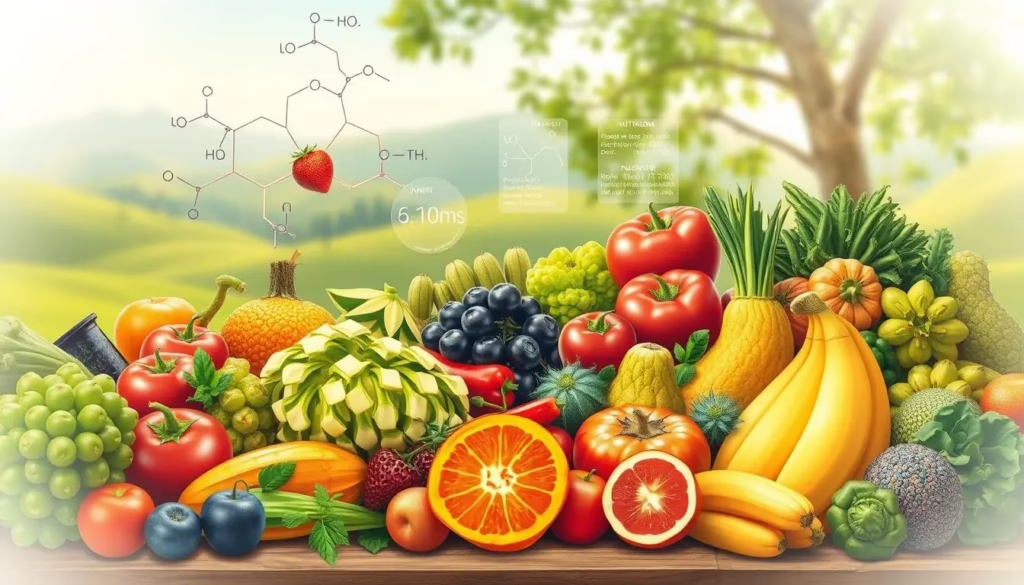
Here’s a breakdown of the macronutrient information for a few of our featured recipes:
| Recipe | Calories | Carbohydrates | Protein | Fat |
|---|---|---|---|---|
| Decadent No-Bake Chocolate Avocado Mousse | 250 | 30g | 5g | 15g |
| Savory Lentil and Root Vegetable Shepherd’s Pie | 400 | 60g | 18g | 10g |
| Fluffy Breakfast Berry and Banana Oat Pancakes | 300 | 60g | 5g | 5g |
By incorporating these recipes into your diet, you can enjoy a balanced and nutritious eating plan that supports your overall health and well-being.
Meal Planning and Prep Tips for Special Dietary Needs
Simplifying meal planning with a few key tips can make a significant difference for individuals following gluten-free, dairy-free, and vegan lifestyles. Effective meal planning not only ensures nutritional balance but also saves time and reduces stress.
Weekly Shopping Guide
Creating a weekly shopping guide is the first step towards successful meal planning. Start by listing the staples you need, such as gluten-free grains, dairy-free milk, and vegan protein sources. Then, plan your meals around seasonal produce to ensure freshness and variety. Consider using meal planning apps or online resources to help organize your shopping list.
| Produce | Grains | Protein Sources |
|---|---|---|
| Fresh Vegetables | Quinoa | Lentils |
| Fruits | Brown Rice | Tofu |
| Leafy Greens | Gluten-Free Pasta | Chickpeas |
Batch Cooking Strategies
Batch cooking is a game-changer for those with special dietary needs. By preparing meals in advance, you can save time during the week and ensure you always have a healthy meal ready. Focus on cooking large batches of grains, roasting vegetables, and preparing proteins that can be used in multiple meals.
Storage and Freezing Instructions
Proper storage and freezing techniques are crucial for maintaining the quality of your meals. Use airtight containers to store cooked meals and label them clearly. When freezing, consider using freezer-safe bags or containers to prevent freezer burn.
Refrigeration Guidelines
For short-term storage, refrigeration is key. Cooked meals can typically be stored in the refrigerator for up to three days. Ensure your refrigerator is at the correct temperature to keep food fresh.
Freezer-Friendly Tips
When freezing meals, it’s essential to cool them down quickly to prevent bacterial growth. Use shallow containers to speed up the cooling process, and label everything with the date.
Reheating Methods
Reheating meals safely is crucial. Use a microwave-safe container and cover your meal to maintain moisture. Alternatively, reheating on the stovetop or in the oven can also be effective methods.
Conclusion
As we’ve explored throughout this article, adopting a gluten-free, dairy-free, and vegan lifestyle can have numerous benefits for overall health and wellbeing. The variety of recipes presented, from the Creamy Coconut Thai Curry to the Decadent No-Bake Chocolate Avocado Mousse, demonstrate that healthy eating can be both delicious and satisfying.
By incorporating these plant-based recipes into your dietary routine, you can experience the advantages of a gluten-free, dairy-free, and vegan lifestyle, including improved digestion, increased energy, and a reduced environmental impact. The key is to focus on whole, nutrient-dense foods and to be mindful of ingredient substitutions and meal planning strategies.
As you continue on your journey towards a healthier lifestyle, we encourage you to experiment with new ingredients, flavors, and recipes. With the right tools and knowledge, you can create a balanced and satisfying diet that aligns with your values and supports your overall wellbeing. By making informed choices and embracing a plant-based lifestyle, you can take the first step towards a healthier, happier you.
Check out more recipes :
Gluten-Free Dairy-Free Vegan Recipes: 5 Must-Try Delicious Meals

